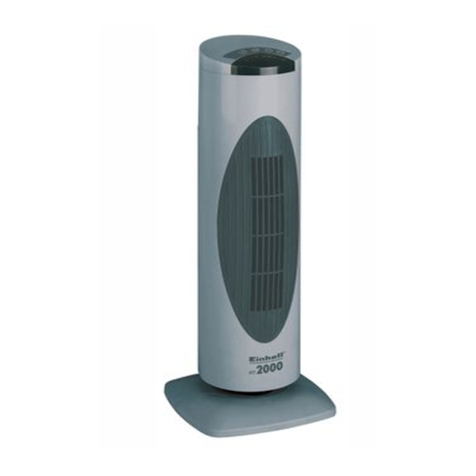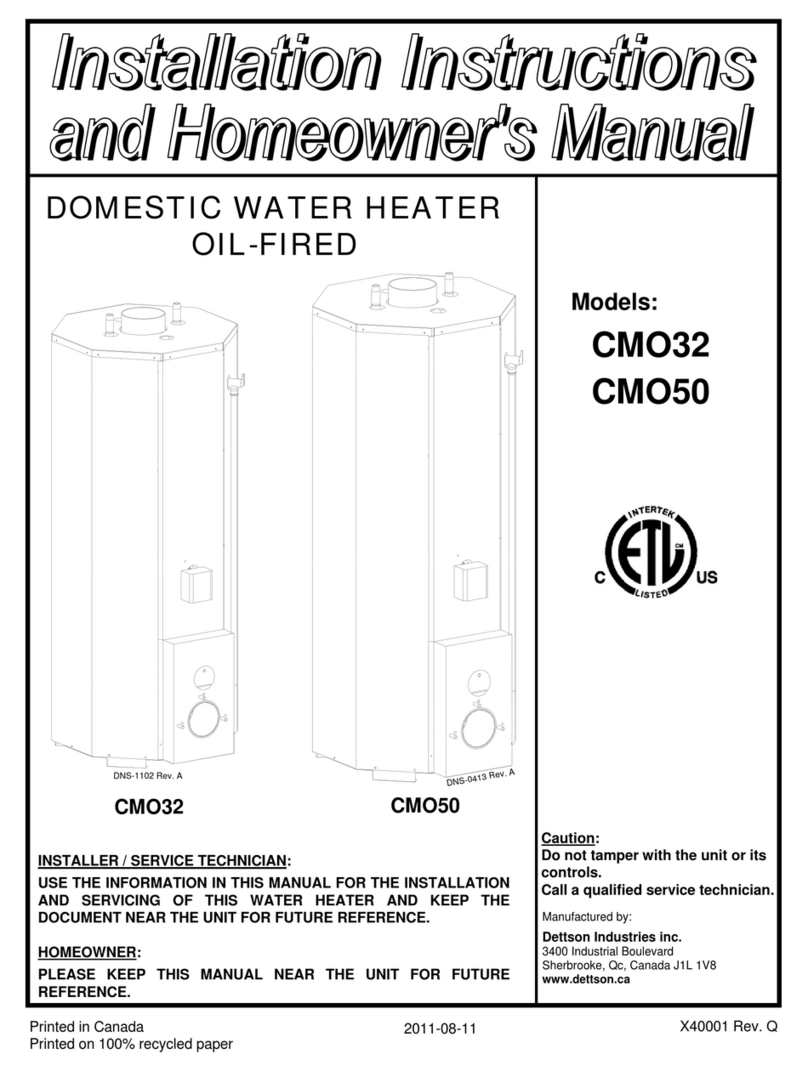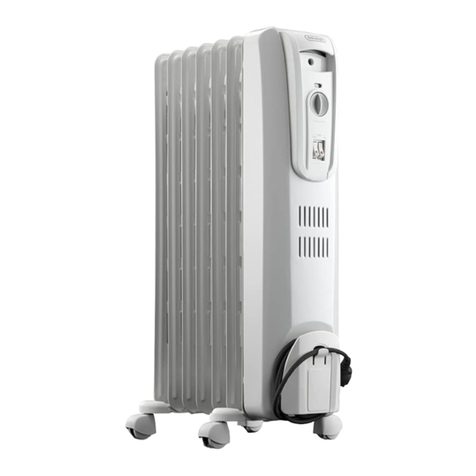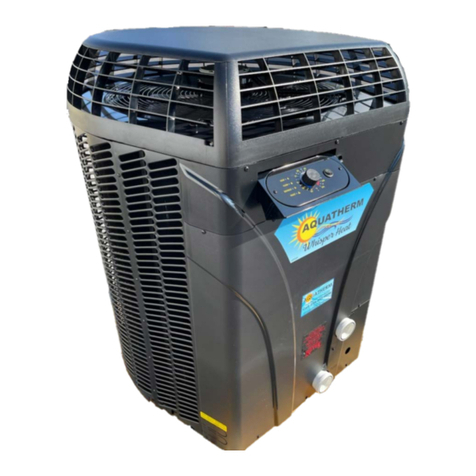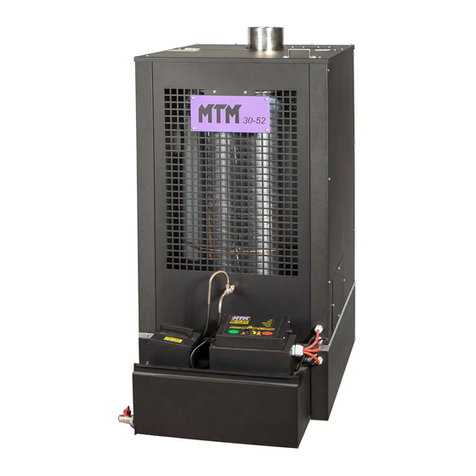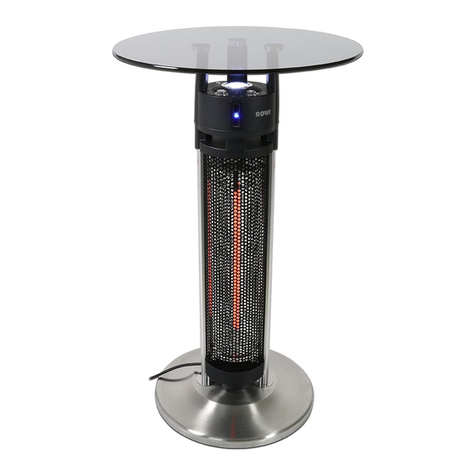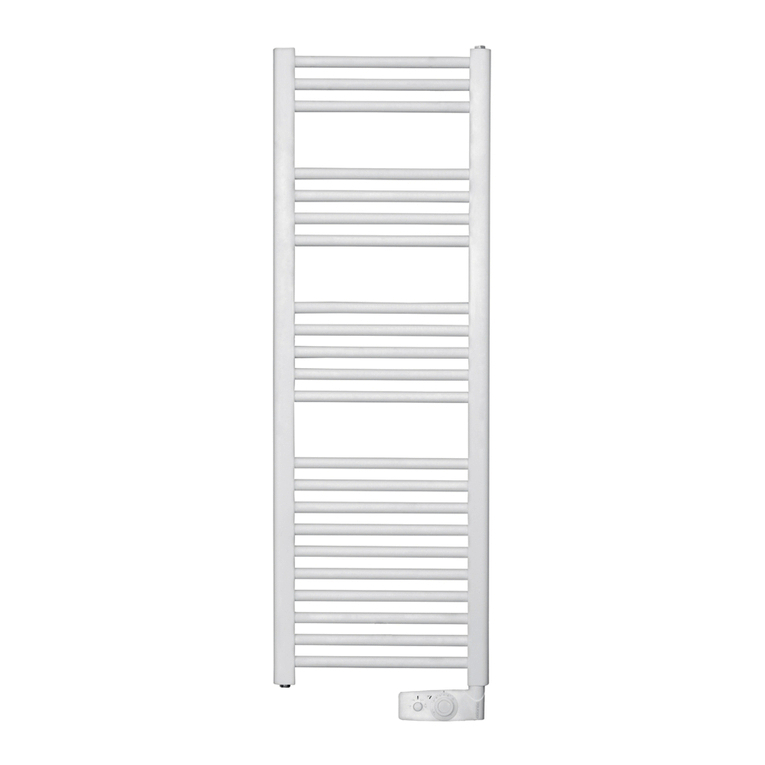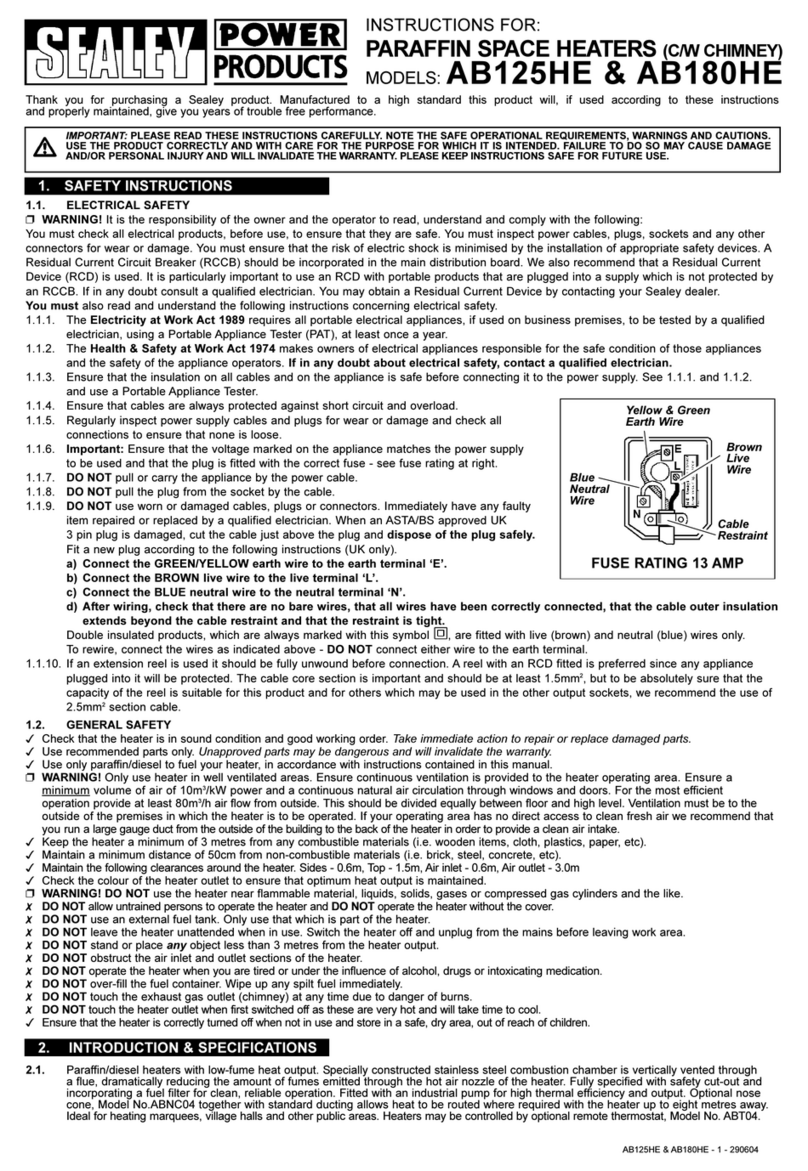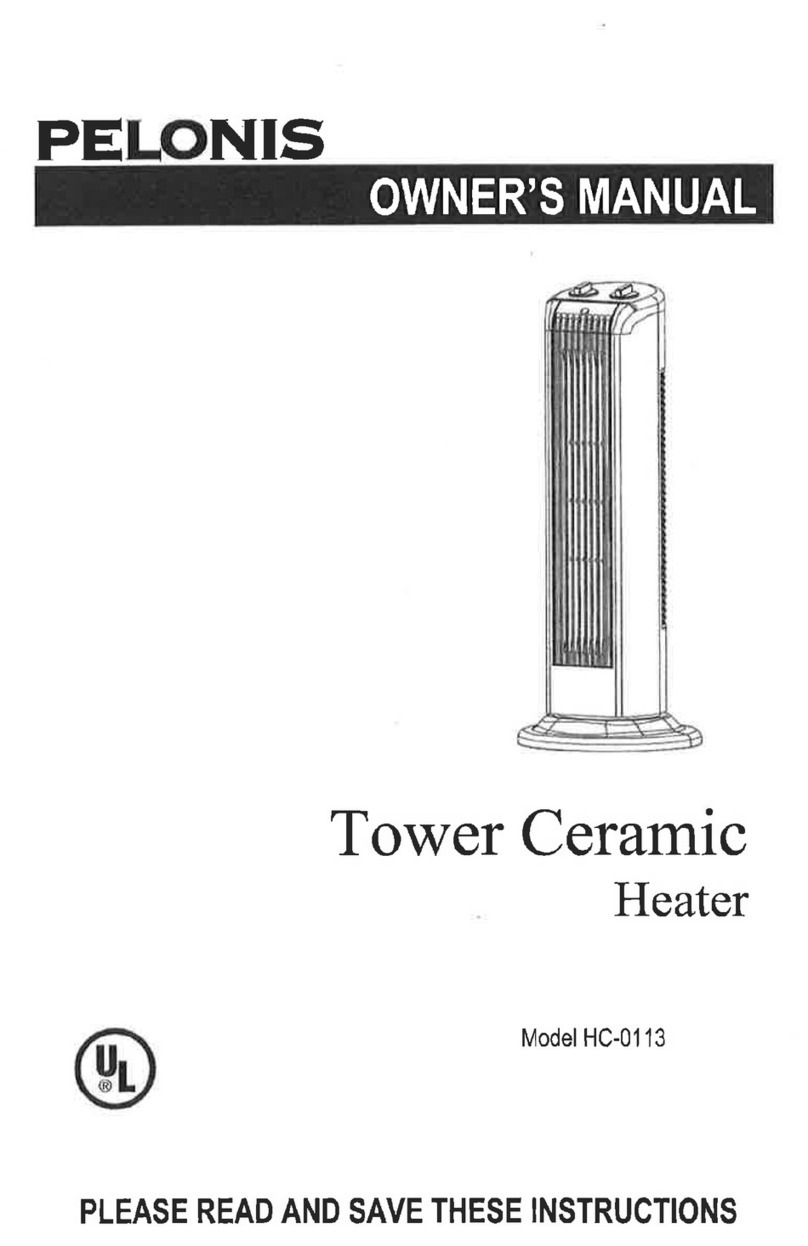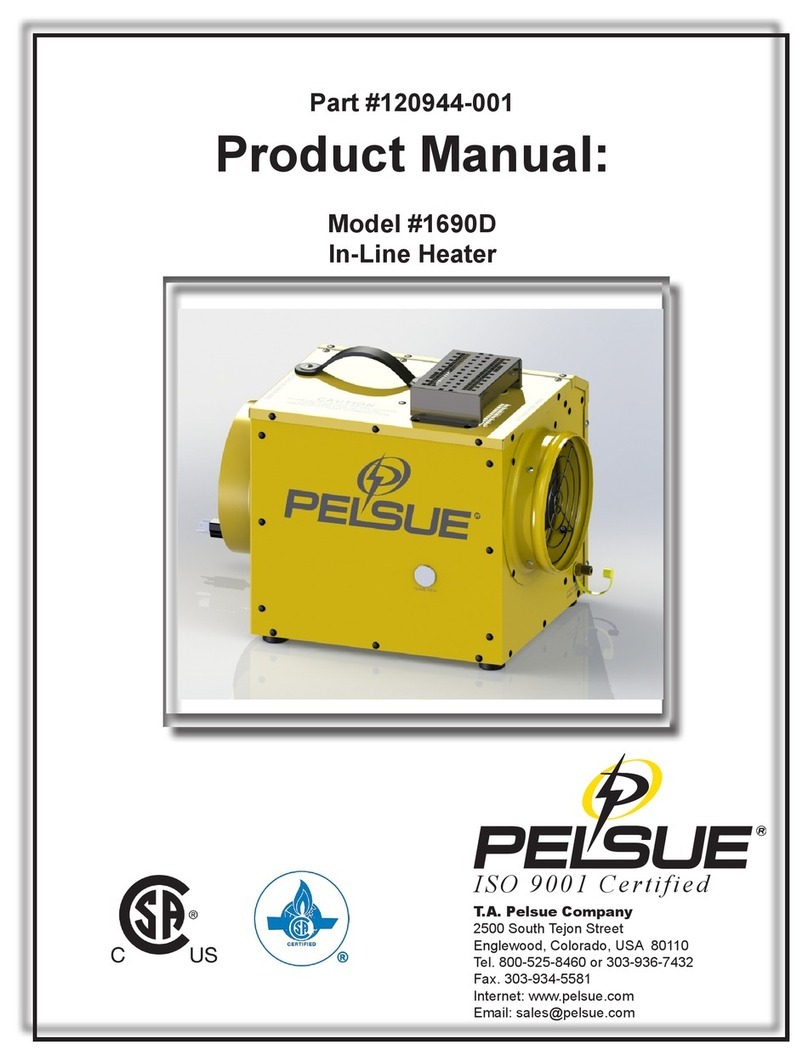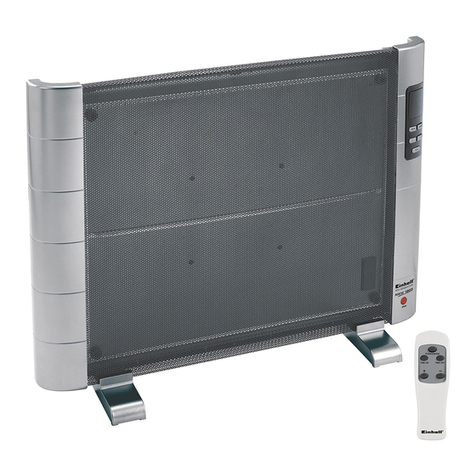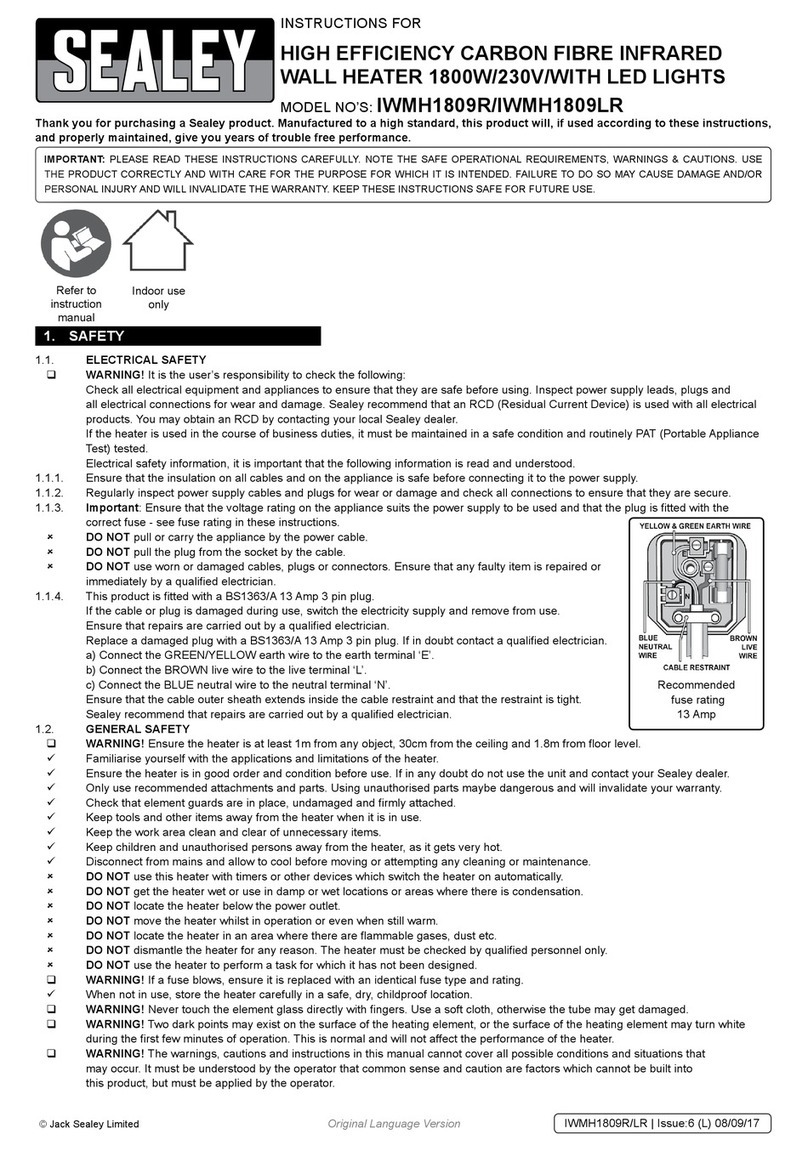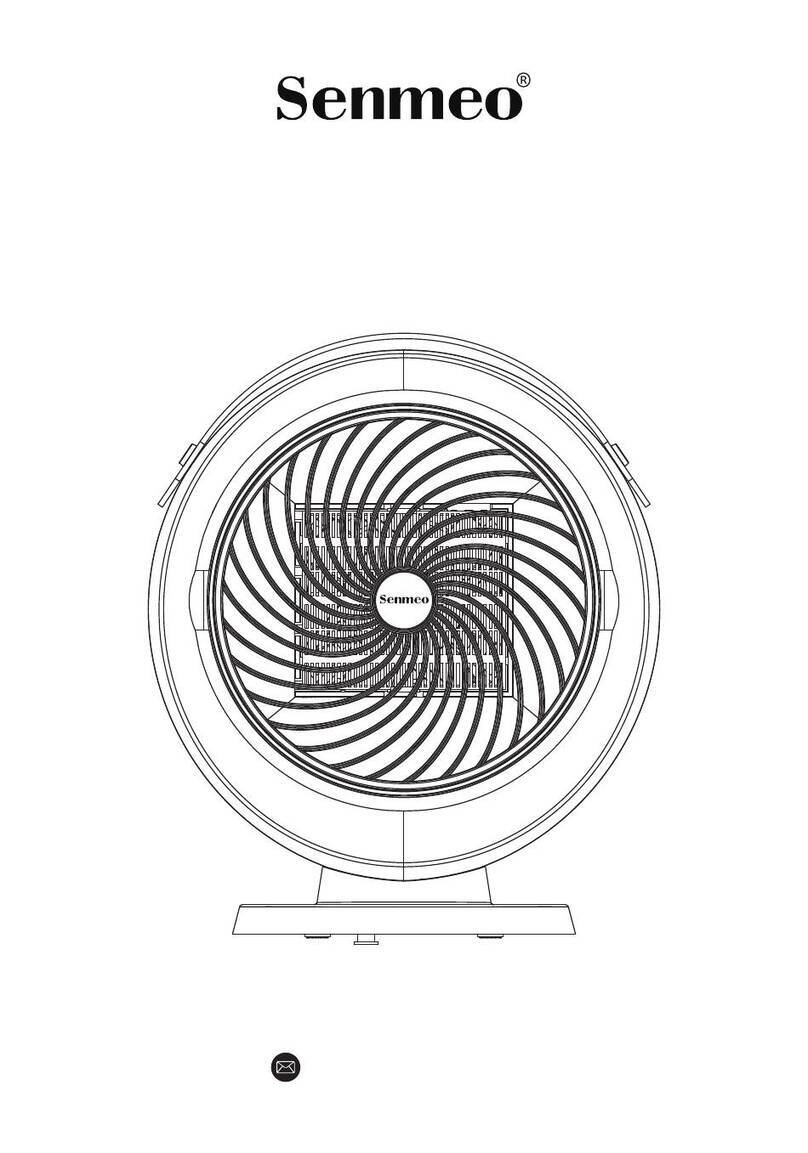S+H Nolting NG-15 User manual

- 0 -
Betriebsanleitung
Operating Instructions
Mode d′utilisation
NG- 15 / 35 / 50 / 75 / 100
Gustav Nolting GmbH
Neuzeitliche Heiztechnik

- 1 -
INHALTSVERZEICHNIS
1. Technische Daten.................................................... Seite 2
2. Allgemeines.............................................................. Seite 3
3. Sicherheitseinrichtungen.......................................... Seite 3
4. Aufstellung/Montage................................................ Seite 3 - 4
5. Inbetriebnahme........................................................ Seite 4
6. Ausserbetriebnahme................................................ Seite 4
7. Wartungsarbeiten..................................................... Seite 4
8. Mögliche Störungen und deren Ursachen................ Seite 5
9. Ersatzteillisten und Bauteileübersicht...................... Seite 6 - 8
10. Elektrische Schaltpläne............................................ Seite 9 - 11
ENGLISH.................................................................. Page 12 - 22
FRANÇAIS............................................................... Pages 23 - 33
06.10.05
NG_DE_EN_FR_7.doc

- 2 -
WICHTIG! UNBEDINGT LESEN!
Lesen Sie die Anleitung vor der Inbetriebnahme des Gerätes sorgfältig durch. Bei Nichtbeachtung
erlischt der Gewährleistungsanspruch. Für Schäden und Folgeschäden, die daraus entstehen,
übernimmt der Hersteller keine Haftung.
1. TECHNISCHE DATEN
Typ NG-15 NG-35 NG-50 NG-75 NG-100
Nennwärmebelastungs-
bereich kW 7,0 – 14,0 18,0 – 35,0 25,0 – 50,0 35,0 – 70,0 50,0 – 100,0
Luftleistung m³/h 480 1.100 1.400 2.000 2.800
Anschlußdruck bar 2,5 – 10,0 2,5 – 10,0 2,5 – 10,0 2,5 – 10,0 2,5 – 10,0
Anschlußwert kg/h 0,54 – 1,09 1,41 – 2,73 1,95 – 3,91 2,73 – 5,47 3,91 – 7,81
Stromaufnahme A 0,48 0,48 0,48 0,60 0,92
Länge mm 500 500 650 800 1.000
Breite mm 220 320 320 370 370
Höhe mm 320 460 460 520 520
Gewicht kg 8,0 14,0 16,0 21,0 26,0
Elektroanschluß V 230/50
Gasart / Kategorie Flüssiggas / I 3 P
Produkt-ID-Nr. CE-0085
AQ 0806
CE-0085
AQ 0232
CE-0085
AQ 0232
CE-0085
AQ 0232
CE-0085
AQ 0232
Steuerungsmöglichkeiten
Halbautomat
mit Piezo-
Zündung
Vollautomatisch mit elektrischer Zündung
Anschluß von Raumthermostat über Steckverbindung
möglich
Technische und maßliche Änderungen vorbehalten.

- 3 -
2. ALLGEMEINES
Gasbefeuerter Warmlufterzeuger (WLE) für
Gewerbe und Industrie. Baureihe NG-15 als
Halbautomat mit Piezo-Zündung und thermo-
elektrischer Flammenüberwachung bzw. Bau-
reihe NG-35 bis NG-100 als Vollautomat mit
elektrischer Zündung und Ionisationsüber-
wachung.
3. SICHERHEITSEINRICHTUNGEN
3.1 Sicherheitseinrichtungen NG-15
Als Sicherheitseinrichtung gegen eine Über-
hitzung wurde der WLE mit einem Thermo-
schalter (Pos.3) ausgestattet.
Der Thermoschalter schaltet den WLE beim
Überschreiten der fest eingestellten Temperatur
aus.
Nach der Auskühlung des WLE muß zuerst die
Ursache behoben und der WLE von Hand in
Betrieb genommen werden (siehe Inbetrieb-
nahme Seite 4).
Der WLE ist zur Flammenüberwachung mit einer
thermoelektrischen Zündsicherung ausgestattet
(Pos. 5). Beim Erlöschen der Flamme wird die
Gaszufuhr sofort unterbrochen.
3.2 Sicherheitseinrichtungen NG-35 – 100
Als Sicherheitseinrichtung gegen eine Über-
hitzung wurde der WLE mit einem Sicher-
heitstemperaturbegrenzer (STB) ausgestattet
(Pos. 15).
Der STB schaltet den WLE beim Überschreiten
der fest eingestellten Temperatur aus.
Die integrierte Wiedereinschaltsperre verhindert
einen erneuten Start des Gerätes.
Nach der Auskühlung des WLE muß zuerst die
Ursache behoben und der STB von Hand
entriegelt werden. Der Entriegelungstaster
befindet sich am Schaltkasten unter der
schwarzen Schraubkappe (Pos. 24).
Danach den Entstörknopf des Gasfeuerungs-
automaten an der Vorderseite des Schaltkastens
drücken (Pos. 16).
Die eingebaute Ionisationselektrode dient als
Flammenüberwachung und ist an einen Gas-
feuerungsautomaten angeschlossen, der die
Gesamtfunktion des WLE steuert und überwacht.
4. AUFSTELLUNG / MONTAGE
Um Personen- und Sachschäden zu
vermeiden sind die jeweiligen örtlichen Bau-,
Brandschutz- und Berufsgenossenschafts-
vorschriften unbedingt zu beachten.
Vor der Aufstellung ist sicherzustellen, daß die
örtlichen Versorgungsbedingungen (Gasart,
Druck) und die gegenwärtige Einstellung des
WLE übereinstimmen.
Der WLE darf nur in gut belüfteten Räumen,
nicht in Wohnräumen oder gleichartigen
Aufenthaltsräumen, betrieben werden.
Um die MAK Grenzwerte im Aufstellungsort
einzuhalten, muß pro KW Geräteleistung eine
Frischluftmenge von mindestens 25 m³/h
gewährleistet sein.
Der Betrieb in feuer- und explosionsgefährdeter
Umgebung ist unzulässig.
Der WLE wird ohne Kaminanschluß auf ebenem
Untergrund frei im Raum aufgestellt.
Der Abstand zu brennbaren Bauteilen sollte
mindestens 1,5 m, auf der Geräteausblasseite
mindestens 3 m betragen.
Das Anbringen von Rohren, Schläuchen o.ä.
sowie Veränderungen des Querschnittes sind
ausblas- und ansaugseitig nicht zulässig.
Achtung !!!
Elektro- und Gasanschluß des WLE nur vom
Fachmann nach den geltenden örtlichen
Vorschriften durchführen lassen! (In
Deutschland z.B. TRGI und TRF)
Elektroanschluß:
Der Elektroanschluß erfolgt über ein angebautes
Netzkabel mit Schutzkontaktstecker an ein
230V/50 Hz Wechselstromnetz.
Gasanschluß:
Am Gerät 3/8“ Außengewinde mit Innenkonus
(Linksgewinde beachten).
Als Zubehör kann der WLE mit einem 3,0 m
langen Gasschlauch, Schlauchbruchsicherung
und einem entsprechenden Druckregler mit
Kombi-Flaschenanschlußgewinde ausgestattet
werden. Die Verbindung an eine Gasleitung hat

- 4 -
mit geeigneten Übergangsstücken zu erfolgen
(Linksgewinde beachten).
Da es ggf. regionale Unterschiede in der
Gaszusammensetzung gibt, ist bei der
Inbetriebnahme vor Ort das einwandfreie Zünden
zu kontrollieren.
Bei nicht einwandfreier Zündung ist die Position
der Zündelektrode anzupassen.
In angemessenen Abständen sollte diese
Kontrolle wiederholt werden.
Der zu verwendende Druckregler muß unbedingt
in seiner Leistung den WLE-Daten entsprechen
(Anschlußdruck und Anschlußwert).
Ansteuerung:
Die Ansteuerung kann über einen Raum-
thermostaten erfolgen, der an die entsprechende
Thermostatsteckdose (Pos. 20) an der Vorder-
seite des Schaltkastens angeschlossen wird.
5. INBETRIEBNAHME
5.1 Inbetriebnahme Gerätetyp: NG-15
Nach dem Öffnen des Gasventils und dem
Einstellen der gewünschten Wärmeleistung am
Schaltkasten des WLE den Betriebsschalter auf
‚ I ‘ stellen. Der Ventilator läuft an.
Den Knopf ‚Startgas‘ thermoelektrische
Zündsicherung (Pos. 5) drücken. Gleichzeitig den
Knopf ‚Gas-Hochspannungszünder‘ (Piezo-
Zünder, Pos. 13) an der Vorderseite des
Schaltkastens mehmals drücken, bis der Brenner
anspringt. Nach dem Zünden den Knopf
‚Startgas‘ 10 Sekunden lang gedrückt halten.
Sollte nach dem Loslassen des Knopfes der
Brenner ausgehen, 1 Minute warten und dann
den Zündvorgang wiederholen.
5.2 Inbetriebnahme Gerätetyp: NG-35 - 100
Nach dem Öffnen des Gasventils und dem
Einstellen der gewünschten Wärmeleistung am
Schaltkasten des WLE den Betriebsschalter
(Pos. 2) auf ‚ I ‘ stellen. Der Ventilator läuft an.
Beim Betrieb mit Raumthermostat muß der
Thermostat über Umgebungstemperatur einge-
stellt werden.
Mit dem Ventilator wird die Zündung automatisch
eingeschaltet und nach einer kurzen Vorspülzeit
das Magnetventil (Pos. 9) geöffnet.
Nach der Flammenbildung wird die Zündung
automatisch abgeschaltet. Das Gerät hat seine
Betriebsstellung erreicht.
Sollte sich die Flamme nach Ablauf der Zündzeit
nicht gebildet haben, wird der o.g. Zündvorgang
bis zu viermal wiederholt. Hat sich danach immer
noch keine Flamme gebildet, schließt das
Magnetventil (Pos. 9) automatisch die Gaszufuhr.
Erlischt die Flamme während des Betriebes,
schließt ebenfalls das Magnetventil sofort die
Gaszufuhr.
Der Gasfeuerungsautomat hat eine Störabschal-
tung und Verriegelung durchgeführt. Die rote
Störlampe am Schaltkasten leuchtet.
Sobald die evtl. Störung behoben ist, kann das
Gerät nach ca. 60 Sek. durch Drücken des
Entstörtasters (Pos. 24) am Schaltkasten wieder
in Betrieb genommen werden.
6. AUSSERBETRIEBNAHME
Wahlschalter auf ‚0‘ stellen und die
Gaszufuhr schließen.
Vor dem Transport muß das WLE vollständig
ausgekühlt sein.
7. WARTUNGSARBEITEN
Um die Betriebssicherheit zu gewährleisten und
eine optimale Wirtschaftlichkeit zu erzielen, muß
der WLE in angemessenen Abständen gewartet
und gereinigt werden.
Hierzu muß folgendes unbedingt beachtet
werden:
•Bei Wartungsarbeiten den Netzstecker ziehen
und die Gaszufuhr schließen.
•Der WLE, besonders der Brenner und der
Ventilator, sind in angemessenen
Zeitabständen auf Verschmutzung zu
überprüfen und ggf. zu reinigen.
•Zur Reinigung kein Wasser verwenden!
•Nur Originalersatzteile verwenden!
•Reparaturarbeiten an strom- und
gasführenden Komponenten nur von Fach-
leuten durchführen lassen!
•Nach erfolgten Wartungsarbeiten ist das
Inbetriebnahmeverfahren mit Funktions-
kontrolle erneut durchzuführen.

- 5 -
8. MÖGLICHE STÖRUNGEN UND DEREN URSACHEN:
Störung: Ursache: Abhilfe:
WLE startet nicht Kein Raumthermostat
angeschlossen oder Brücke an
der Thermostatsteckdose
(Pos. 20) fehlt
Raumthermostat falsch
eingestellt
Gasversorgung
Raumthermostat anschließen
oder Brücke an der Thermo-
statsteckdose herstellen
Einstellung überprüfen
Überprüfen
WLE läuft an, Zündung ist vor-
handen, aber Magnetventil öffnet
nicht ..........Störabschaltung
Sicherheitsthermostat hat
ausgelöst oder ist defekt
(Pos.15)
Gasfeuerungsautomat defekt
(Pos. 16)
Entriegeln bzw. austauschen
Austauschen
WLE läuft an, keine Zündung,
Magnetventil öffnet, Gas strömt
ein ..........Störabschaltung
Zündelektrode defekt (Pos. 12)
Zündspalt zu groß
Zündkabel defekt (Pos. 7)
Gasfeuerungsautomat defekt
(Pos. 16)
Austauschen
Verkleinern
Austauschen
Austauschen
WLE läuft an, Zündung ist vor-
handen, Magnetventil öffnet, Gas
strömt ein, wird entzündet ..........
nach wenigen Sekunden erfolgt
die Störabschaltung
Gasfeurungsautomat defekt
(Pos. 16)
Ionisationskabel verschmutzt
oder defekt (Pos. 23)
Ionisationselektrode verschmutzt
oder defekt (Pos. 17)
Austauschen
Reinigen bzw. austauschen
Reinigen bzw. austauschen
WLE läuft an, Zündung ist vor-
handen, Magnetventil öffnet,
kein Gas strömt ein ..........
Störabschaltung
Gasdruckregler defekt (Pos. 14)
Gasdruck
Düse verstopft
Magnetventil oder Gasleitung
verstopft (Pos. 9)
Austauschen
Überprüfen
Reinigen, austauschen
Reinigen bzw. durchblasen
WLE geht gelegentlich auf
Störung
Ionisations-Zündelektrode
(Pos. 17)
Zündung
Schaltkasten
Gasdruck
Überprüfen
Überprüfen
Auf lose Klemmen überprüfen
Überprüfen

- 6 -
9. ERSATZTEILLISTE UND BAUTEILEÜBERSICHT
NG
Pos. Bezeichnung 15
Art-Nr.
35
Art-Nr.
50
Art-Nr.
75
Art-Nr.
100
Art-Nr.
1 Brenner 100072 101378 101378 100504 100504
2 Betriebsschalter 100994 100994 100994 100994 100994
3 Thermoschalter 101170 ----- ----- ----- -----
4 Schutzgitter vorn 100766 100768 100768 100983 100983
5 Thermoelektrische Zündsicherung 101993 ----- ----- ----- -----
6 Thermoelement 101994 ----- ----- ----- -----
7 Zündkabel 102346 1-00535 1-00535 1-00535 1-00535
8 Motor 102450 102384 102384 ----- -----
9 Magnetventil 102471 102471 102471 101141 101141
10 Lüfterrad 102661 102389 102389 ----- -----
11 Thermostromunterbrecher 102814 ----- ----- ----- -----
12 Zündelektrode 103314 103312 103312 103311 103311
13 Piezozünder 103315 ----- ----- ----- -----
14 Geräteregler 103040 103040 103040 103040 103040
15 Sicherheitstemperaturbegrenzer STB ----- 100219 100219 100219 100219
16 Gasfeuerungsautomat DVI ----- 103946 103946 103946 103946
17 Ionisationselektrode ----- 1-00529 1-00529 1-00529 1-00529
18 Entstörkondensator ----- 1-00394 1-00394 1-00394 1-00394
19 Kondensator 5 µF ----- ----- ----- 101377 101377
20 Thermostatsteckdose 102715 102715 102715 102715 102715
21 Gas – Set 02-048-26 103358 103358 103358 103358 103358
22 Ventilator ----- ----- ----- 102394 101152
23 Ionisationskabel ----- 1-00536 1-00536 1-00536 1-00536
24 Entstörtaster ----- 103718 103718 103718 103718
Zur Reparatur nur Originalteile des Herstellers verwenden!

- 7 -
NG – 15 / - 35 / - 50

- 8 -
NG – 75 / - 100

- 9 -
11. ELEKTRISCHER SCHALTPLAN Gerätetyp : NG-15

- 10 -
11. ELEKTRISCHER SCHALTPLAN Gerätetyp : NG-35 / 50

- 11 -
11. ELEKTRISCHER SCHALTPLAN Gerätetyp : NG-75 / 100

- 12 -
TABLE OF CONTENTS
1. Technical Data……................................................... Page 13
2. General..................................................................... Page 14
3. Safety Features........................................................ Page 14
4. Installation/ Assembly............................................... Page 14 - 15
5. Initial operation and further start-ups......................... Page 15
6. Placing out of service................................................. Page 15
7. Maintenance.............................................................. Page 15
8. Possible malfunctions and their causes.................... Page 16
9. Spare Parts List and Components Overview............ Page 17 - 19
10. Electrical circuit diagrams......................................... Page 20 - 22
DEUTSCH................................................................. Seite 1 - 11
FRANÇAIS............................................................... Pages 23 - 33

- 13 -
IMPORTANT! READ CAREFULLY!
Please read the introduction carefully before the initial operation of the equipment. In the event of
non-compliance, any warranty claim becomes null and void. The manufacturer is not responsible for
damages or consequential damages that may arise therefrom.
1. TECHNICAL DATA
Type NG-15 NG-35 NG-50 NG-75 NG-100
Nominal heat loading
capacity range kW 7.0 – 14.0 18.0 – 35.0 25.0 – 50.0 35.0 – 70.0 50.0 – 100.0
Air capacity m³/h 480 1,100 1,400 2,000 2,800
Connection pressure bar 2.5 – 10.0 2.5 – 10.0 2.5 – 10.0 2.5 – 10.0 2.5 – 10.0
Connected load kg/h 0.54 – 1.09 1.41 – 2.73 1.95 – 3.91 2.73 – 5.47 3.91 – 7.81
Power consumption A 0.48 0.48 0.48 0.60 0.92
Length mm 500 500 650 800 1.000
Width mm 220 320 320 370 370
Height mm 320 460 460 520 520
Weight kg 8.0 14.0 16.0 21.0 26.0
Electrical connection V 230/50
Gas type/ Category LPG / I 3 P
Product ID NoCE-0085
AQ 0806
CE-0085
AQ 0232
CE-0085
AQ 0232
CE-0085
AQ 0232
CE-0085
AQ 0232
Control possibilities
Semi-
automatic
with Piezo-
Ignition
Fully automatic with electrical ignition
Connection of room thermostat possible using plug-in
connection
We reserve the right to make technical and dimensional changes.

- 14 -
2. GENERAL
Gas-fired warm air heater (WAH) for commercial
and industrial applications. The
NG-15 series as semi-automatic unit with piezo-
ignition and thermoelectrical flame control or the
NG-35 to NG-100 as a fully-automatic device with
electrical ignition and ionization monitoring.
3. SAFETY FEATURES
3.1 NG-15 Safety Features
The WAH is equipped with a safety temperature
controller (Item 3) as a safety feature to prevent
overheating.
The thermo-switch shuts down the WAH upon
exceeding the defined temperature.
After cool-down of the WAH the cause must first
be eliminated and the WAH must then be
restarted manually (see “Initial operation and
further start-ups”, page 15).
The WAH is equipped with a thermoelectric flame
failure control for flame monitoring (Item 5).
When the flame extinguishes, gas supply is
immediately interrupted.
3.2 NG-35 - NG-100 Safety Features
The WAH is equipped with a safety temperature
controller (STC) as a safety feature to prevent
overheating. (Item 15 )
The STC shuts down the WAH upon exceeding
the defined temperature.
The integrated restart lock prevents restarting of
the device.
After cooling the WAH, the cause must be
eliminated and the STC must be manually
released. The reset button is located on the
control box under the black screw cap (Item 24).
Then press the release button for the automatic
gas-firing device on the front panel of the
switching box (Item 16).
The built-in ionization electrode serves as a flame-
monitoring device and is connected to the
automatic gas-firing unit that controls and
monitors the overall function of the WAH.
4. INSTALLATION/ ASSEMBLY
In order to prevent personal injury and
property damage, the relevant local building,
fire-prevention and professional
organizational regulations must be
unconditionally observed.
Before setting up it must be ensured that the
local supply conditions (gas type, pressure)
and the current setting of the WAH
correspond.
The WAH may be operated only in well-ventilated
spaces and must not be used in residential or
similar premises.
To comply with the MAC limit values at the set-up
location, for each KW of device output a fresh air
exchange rate of at least 25 m3/h must be
ensured.
Operation in environments at risk of fire or
explosion is prohibited.
The WAH is set up freely in the room on a level
surface without a chimney connection.
The distance from combustible parts must be at
least 1.5 m,, on the outlet side of the device at
least 3 m.
Any attachment of pipes, hoses or the like as well
as changes to the cross-section is prohibited on
the inlet and outlet side.
Caution!!!
WAH electrical and gas hookups must be
done only by a specialist and in accordance
with local standards.
Electrical Connection
The electrical connection is made using a built-in
power cable with three-wire grounded plug to a
230 V / 50 Hz a.c. power line.
Gas Hook-up
3/8" external thread with inner cone (note left-
hand thread) on the device.
The WAH can be equipped with a 3.0 m long gas
hose, hose break protection and a corresponding
pressure regulator with combination bottle
connection thread as accessories. The connection
to the gas lines must be made using appropriate
connectors (note left-hand thread).

- 15 -
Since there may be regional differences in gas
composition, proper igniting must be checked on
site at the time of initial operation.
In the event of imperfect ignition, the position of
the ignition electrode must be adapted.
These inspections should be repeated at regular
intervals.
The performance of the pressure regulator to be
used must unconditionally correspond to the
WAH data (connection pressure and connection
load).
Control:
Control can be achieved using a room thermostat
that is connected to the respective thermostat
jack (Item 20) on the front panel of the switch
box.
5. INITIAL OPERATION AND
FURTHER START-UPS
5.1 Initial operation and further start-ups of
Device Type: NG-15
After opening the gas valve and setting the
desired heat output on the switching box of the
WAH, set the operating switch to I. The fan will
start.
Press the Start Gas thermoelectric ignition
security (Item 5) button. At the same time
depress the button Gas High Voltage Ignition
(piezo-igniter, Item 13) on the front panel of the
switch box several times, until the burner cuts in.
After ignition, press the Start Gas button for 10
seconds. If after releasing the button, the burners
go out, wait one minute and then repeat the
ignition procedure.
5.2 Initial operation and further start-ups of
Device Type: NG-35-100
After opening the gas valve and setting the
desired heat output on the switching box of the
WAH, set the operating switch to I(Item 2).The
fan will start.
In the case of operation using a room thermostat,
the thermostat must be set using room
temperature.
With fan, ignition is automatically turned on and
after a short pre-purge time, the solenoid (Item 9)
is opened.
After establishing the flame, ignition is
automatically shut off. The device has reached its
operating setting.
If the flame has not yet formed after lapse of the
ignition time, the aforesaid ignition procedure is
repeated up to four times. If the flame has still not
formed, the solenoid (Item 9) automatically closes
the gas supply.
Likewise, if the flame goes out during operation,
the solenoid will immediately close the gas supply.
The automatic gas-firing unit has executed a fault
shut-down and executed an interlock. The read
fault light on the switching box lights up.
Once any fault has been eliminated, after
approximately 60 sec the device can be restarted
by pressing the reset button (Item 24).
6. PLACING OUT OF SERVICE
Place the selection switch in the 0position
and close the gas infeed.
The WAH must be completely cooled prior to
transport.
7. MAINTENANCE
For assuring operational reliability and to achieve
optimal efficiency, the WAH must be serviced and
cleaned at appropriate intervals.
To do this the following must be unconditionally
observed:
•When carrying out maintenance, disconnect
the mains plug and close the gas line.
•The WAH, especially the fan must be checked
at regular intervals for dirt and, if necessary,
cleaned.
•Do not use water for cleaning!
•Use only the original equipment
manufacturer's replacement parts.
•Repairs to electrical and gas conducting
components must be done only by specialist
personnel!
•On completion of service work, initial start-up
together with function check must be re-done.

- 16 -
8. POSSIBLE MALFUNCTIONS AND THEIR CAUSES:
Malfunction: Cause: Remedy:
WAH does not start No room thermostat connected or
no bridge on the thermostat jack
(Item 20)
Room thermostat incorrectly set
Gas hookup
Connect the room thermostat
or bridge to the thermostat
jack
Check setting
Check
WAH starts, ignition present
but solenoid valve does not
open………….fault shutdown.
Safety thermostat triggered or is
defective (Item 15)
Automatic gas firing unit
defective (Item 16 )
Reset or replace
Replace
WAH starts, no ignition,
solenoid valve opens,
gas flows in….fault shutdown.
Ignition electrode defective
(Item 12)
Ignition gap too large
Ignition cable defective (Item 7)
Automatic gas firing unit
defective (Item 16 )
Replace
Reduce
Replace
Replace
WAH starts, ignition present,
solenoid valve opens, gas
flows in, is ignited …………
after several seconds fault
shutdown occurs.
Automatic gas firing unit
defective (Item 16 )
Ionization cable dirty or defective
(Item 23)
Ionization electrode dirty or
defective (Item 17)
Replace
Clean or replace
Clean or replace
WAH starts, ignition present,
solenoid valve opens, no gas
flows in………fault shutdown.
Gas regulator defective (Item 14)
Gas pressure
Nozzle clogged
Solenoid or gas line clogged
(Item 9)
Replace
Check
Clean, replace
Clean by blow-through
WAH occasionally goes to fault. Ionization ignition electrode
(Item 17 )
Ignition
Switch box
Gas pressure
Check
Check
Check for loose contacts
Check

- 17 -
9. SPARE PARTS LIST AND OVERVIEW OF COMPONENTS
NG
Item Name 15
Item No35
Item No50
Item No75
Item No100
Item No
1 Burner 100072 101378 101378 100504 100504
2 Operating switch 100994 100994 100994 100994 100994
3 Thermoswitch 101170 ----- ----- ----- -----
4 Protective grid, front 100766 100768 100768 100983 100983
5 Thermoelectrical pilot lighting 101993 ----- ----- ----- -----
6 Thermo-element 101994 ----- ----- ----- -----
7 Ignition cable 102346 1-00535 1-00535 1-00535 1-00535
8 Motor 102450 102384 102384 ----- -----
9 Solenoid valve 102471 102471 102471 101141 101141
10 Fan wheel 102661 102389 102389 ----- -----
11 Thermo-circuit breaker 102814 ----- ----- ----- -----
12 Ignition electrode 103314 103312 103312 103311 103311
13 Piezo-igniter 103315 ----- ----- ----- -----
14 Device controller 103040 103040 103040 103040 103040
15 Safety temperature controller (STC) ----- 100219 100219 100219 100219
16 Automatic gas firing unit (DVI) ----- 103946 103946 103946 103946
17 Ionization electrode ----- 1-00529 1-00529 1-00529 1-00529
18 Reset capacitor ----- 1-00394 1-00394 1-00394 1-00394
19 Capacitor 5 µF ----- ----- ----- 101377 101377
20 Thermo jack 102715 102715 102715 102715 102715
21 Gas – Set 02-048-26 103358 103358 103358 103358 103358
22 Fan ----- ----- ----- 102394 101152
23 Ionization cable ----- 1-00536 1-00536 1-00536 1-00536
24 Reset button ----- 103718 103718 103718 103718
Use only OEM parts for repairs!

- 18 -
NG - 15 / - 35 / - 50

- 19 -
NG - 75 / - 100
This manual suits for next models
4
Table of contents
Languages:
Other S+H Nolting Heater manuals



